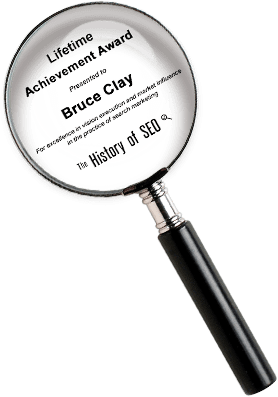Sweat the small stuff
Bruce Clay Australia does SEO (Search Engine Optimization) and works on some very large websites. Too large to handcraft or edit each individual page. Many of these sites have in excess of 100,000 pages indexed and some in excess of a million pages indexed.
While managing millions of pages can be a little like steering a large ship i.e. you head in a general direction, the user, on average takes a selfish perspective and wants unique, customized content on the pages applicable to their want or need.
Search engines on average deliver a significant percentage of a website’s total visitors, and those entering a site from a search engine result page (SERP) can be from different cultural backgrounds, languages and countries. These users have found the site by searching on a relevant search phrase and are usually unforgiving. If you don’t look, behave or have what they want, they are gone, but at the same time, given they are searching, if they like what they see, the potential for conversion is high.
- Challenge for large websites
- Site structure
- Technical elements
- Copywriting
- Engagement objects
- Page speed
- Conversion
- Social signals
- Links
- Usability and accessibility
- UGC
- FAQ: How can I effectively optimize a large website for individual user needs and search engine success?

The challenge for large websites
How do you make a large, complex website targeting “the world” relevant to a specific individual, who wants to find something specific to their needs, in their local neighborhood, in a hurry.
For example, say you operate a restaurant review website with millions of pages targeting restaurants around Australia. Your search engine user is a single mom searching for the cheapest, kid friendly Chinese restaurant closest to her home, offering value for money, acceptable quality, and paper table covers so the kids can draw on them. You see the problem?
Not only that, but large sites inevitably run into duplicate content issues, complexities around site structure, the challenge of getting all pages in the site spidered by the search engines, as well as the need to create content for sufficient link acquisition.
Large website SEO Considerations and more
1. Site structure:
If you do not start upfront with a logical and hierarchical site structure, over time, the chances are that your site will become unwieldy and harder to manage, especially when it comes time to add new content or categories.
Also, ensure you consider what keywords and keyword phrases people actually look for when deciding on this site structure. For example, for the restaurant site, people may search on average as follows:
- restaurant name
- suburb + restaurant
- restaurant type (e.g. Chinese) + restaurant + suburb
- restaurant attribute (e.g. cheap, take away etc) + restaurant type + restaurant + suburb
- and so on and so on…
You might want to consider having landing pages for these search phrases.
2. Technical elements
You can argue all you like about HTML elements and which ones are better than others. Does the H1 count? Do I need a Meta Keywords tag? What about breadcrumbs? Is the Image alt more powerful than the H1 tag? etc. etc. The bottom line is that the more of these you get right the better, SEO is a competition, so make sure your site template includes all SEO-relevant HTML elements and that these are populated correctly.
Writing unique title tags for each page can be a challenge, so understand if there are any automated options such as “make H1 the page name and title,” etc. understand how these are applied and how they will impact each webpage. Make sure you can get relevant text into the required HTML elements without being spammy or duplicated.
Building internal links and HTML sitemaps is also a good way of ensuring that your entire site gets spidered by the search engines. Think about it this way: if I could pour a glass of water into my home page, would it drip out the lowest level pages in my site?
Finally, your CMS (Content Management System) can also be responsible for generating duplicate pages in various forms. Audit your CMS and how it renders content to ensure you minimize duplicate content using canonical tags, Google Search Console, or Meta tags as required.
3. Copywriting
Train your copywriters. Make sure they are aware of SEO, using keywords and keyword phrases, as well as associated words on the page, and that while “tone of voice” might be sexy, it is often not all that sexy to the search engines.
Where pages are generated dynamically and have little or no unique content, review these pages and consider the following:
- Are the SEO-relevant HTML elements present and populated?
- Do they make sense?
- Are these pages unique or are they highly duplicated across the site?
- Where do they link to?
- What relevance to the user are they and what do you want the user to do once read?
- What screen resolution do my users mostly use, what will they see when they arrive?
4. Engagement Objects
Have you got engaging tools useful to the user, such as a restaurant finder, what pages does this generate dynamically? Will these be indexed? Do we want these pages indexed?
Blogs are a great way of building engagement, links and ensuring changing and flexible content on the site, as well as social signals. Is there a blog? Is it useful and managed properly?
Images. Pictures of smiling kids and good looking people are great but do they add any value, unless of course, you are building a dating site? Try considering images that are more useful to the user, graphs, charts etc. Think about how these are used or created across the website. If you have numerous images, think about setting up a gallery of all site images in addition to using them on various pages.
Video. Recent posts from Google indicate the growing importance to Google of getting your videos optimised and indexed. Videos on a page are good engagement objects, just consider your strategy and whether you submit to YouTube, host them yourself, or both, and how you optimize these videos accordingly.
5. Page speed
On average dealing with code at a page level will produce results with respect to speed rather than running out and buying new servers, and is of course, a lot cheaper. Use one of the many tools around to check your site speed and implement the recommendations. Google Search Console (GSC) gives recommendations and will benchmark your site speed to similar sites.
6. Conversion
So you spend all this time and money, are very excited about the launch, and don’t consider what you actually want people to do at a page level. Note, I am not talking about a site level here. All or most sites would have some sort of objective attached.
You create a beautiful landing page, but don’t make what the user should do once they have read the page obvious. Likewise with articles, you pay money, get them written, and then rely on your footer to get them to convert? What user path do you have in mind when a user arrives unannounced from a search engine at a page deep within your site structure?
At a minimum, try to get your users to subscribe to your newsletter by just inputting their email address.
7. Social signals
You may have heard the old adage, “man cannot live by bread alone”, and before I get comments about being sexist, don’t shoot the messenger. Likewise it is harder and harder for a website to live without social signals. Social signals being references and mentions from around the web, to your site and domain name. If you are being spoken about, you must exist, right?
8. Links
Creating high-quality enough content that helps you amplify your website across the social media sphere, and also results in acquiring links is key. We want to acquire links back to the website naturally, without forcing them, or being spammy through artificial means like link building. This is where the challenge lies: achieving the balance of crafting that higher-quality content that will achieve the results you need for your brand.
9. Usability and Accessibility
Many usability and accessibility factors tie closely into SEO and the guidelines provided by search engines. This article is not about usability, but on large sites, this should not be overlooked, especially for your users with disabilities. If you overlook certain things, such as the right alternative text for your images, you might find yourself liable in an accessibility lawsuit, which Target.com found out the hard way a few years back.
10. UGC (User Generated Content)
Be careful what you wish for. The dream can be multiple users, interacting on your site, building free content for you. The reality can be high levels of sometimes costly moderation, playing referee between squabbling members and arbitrary, low value content.
Think about your objectives, your target market and what you want to discuss; try to build a valuable community, rather than a free-for-all all community. Think about the comments you encourage, where you encourage people to comment, and on what topic.
Operating a large website increasingly requires attention to detail and flexibility to meet increasingly demanding user’s expectations. SEO should not be overlooked as part of these efforts, as if done correctly can significantly change your traffic volumes, bringing relevant users to your website and increasing your ROI.
Optimize your content strategy with these proven editorial plan components for heightened SEO effectiveness and audience engagement. Contact us.
FAQ: How can I effectively optimize a large website for individual user needs and search engine success?
Optimizing a large website for individual user needs while ensuring search engine success is a complex endeavor that requires a comprehensive strategy. The balance between online visibility, customer satisfaction, and business growth are essential elements for online success. In this whitepaper we explore the complexities associated with optimizing large sites as well as offering expert insights and actionable advice to ensure success in this challenging endeavor.
Understanding the Challenge
Large websites are a treasure trove of information, catering to diverse user needs. But their size can make them a challenge to optimize effectively. The key lies in aligning user experience with the requirements of search engines. Let’s explore the critical aspects.
- Site Structure
Creating a well-organized site structure is essential. Divide content into categories and use logical, user-friendly navigation. This ensures users can easily find what they’re looking for, while search engines can crawl and index your pages efficiently.
- High-Quality Content
Content is king. Make sure your website offers engaging and useful content tailored specifically to the needs of its audience. Blogs, videos, and infographics can help increase user engagement as well as search engine visibility.
- Keyword Strategy
A robust keyword strategy is crucial. Research and identify keywords relevant to your niche and incorporate them strategically into your content. Use long-tail keywords for specific user needs.
- Mobile Optimization
Given the prevalence of mobile users, your website must be mobile-responsive. Google’s mobile-first indexing prioritizes mobile-friendly sites, making this a critical element for SEO success.
- Page Load Speed
Optimize page load speed to enhance user experience. Slow-loading pages frustrate users and can negatively impact your search engine rankings.
Smooth Transitions
To transition smoothly between these critical subtopics, consider implementing a site audit. Analyze your website’s current status regarding structure, content quality, keywords, mobile optimization, and page load speed. This audit will help you identify areas that need improvement, ensuring a comprehensive approach to optimization.
Step-by-Step Procedure for Effectively Optimizing a Large Website for Usability and Accessibility
Now, let’s outline a step-by-step procedure to effectively optimize a large website for individual user needs and search engine success:
- Conduct a comprehensive site audit to assess your current website’s status.
- Identify user personas and their specific needs.
- Develop a logical site structure that reflects user personas.
- Create high-quality, user-centric content for each persona.
- Perform keyword research and integrate relevant keywords into your content.
- Implement on-page SEO best practices, including meta tags, headers, and keyword placement.
- Optimize images and other media elements for faster loading times.
- Ensure your website is mobile-responsive and user-friendly on all devices.
- Set up Google Analytics and other tracking tools to monitor user behavior.
- Monitor your website’s performance and adapt your strategy based on data insights.
- Regularly update and refresh your content to keep it relevant and valuable.
- Acquire high-quality backlinks by writing high-quality content that resonates with your social media ecosystem, and thus results in natural links from authority websites in your niche.
- Monitor your website’s SEO performance and make necessary adjustments.
- Create an XML sitemap and submit it to search engines.
- Utilize schema markup to enhance search engine understanding of your content.
- Engage in content marketing and social media promotion to increase your website’s visibility.
- Monitor and improve user experience by addressing user feedback and optimizing site speed.
- Track your website’s performance and adapt your strategy as search engine algorithms evolve.
- Stay updated with SEO trends and best practices.
- Regularly review and refine your optimization strategy to ensure long-term success.
Optimizing an extensive website for individual user needs and search engine success is an ongoing journey that requires dedication, strategy, and expertise. By implementing the steps outlined in this whitepaper and staying committed to monitoring and adapting your approach, you can position your website for sustained success in the competitive online landscape. Balancing user satisfaction with search engine visibility is a challenging but rewarding endeavor that will drive your online presence to new heights.
This article was updated on November 23, 2023.

LEAVE A REPLY









